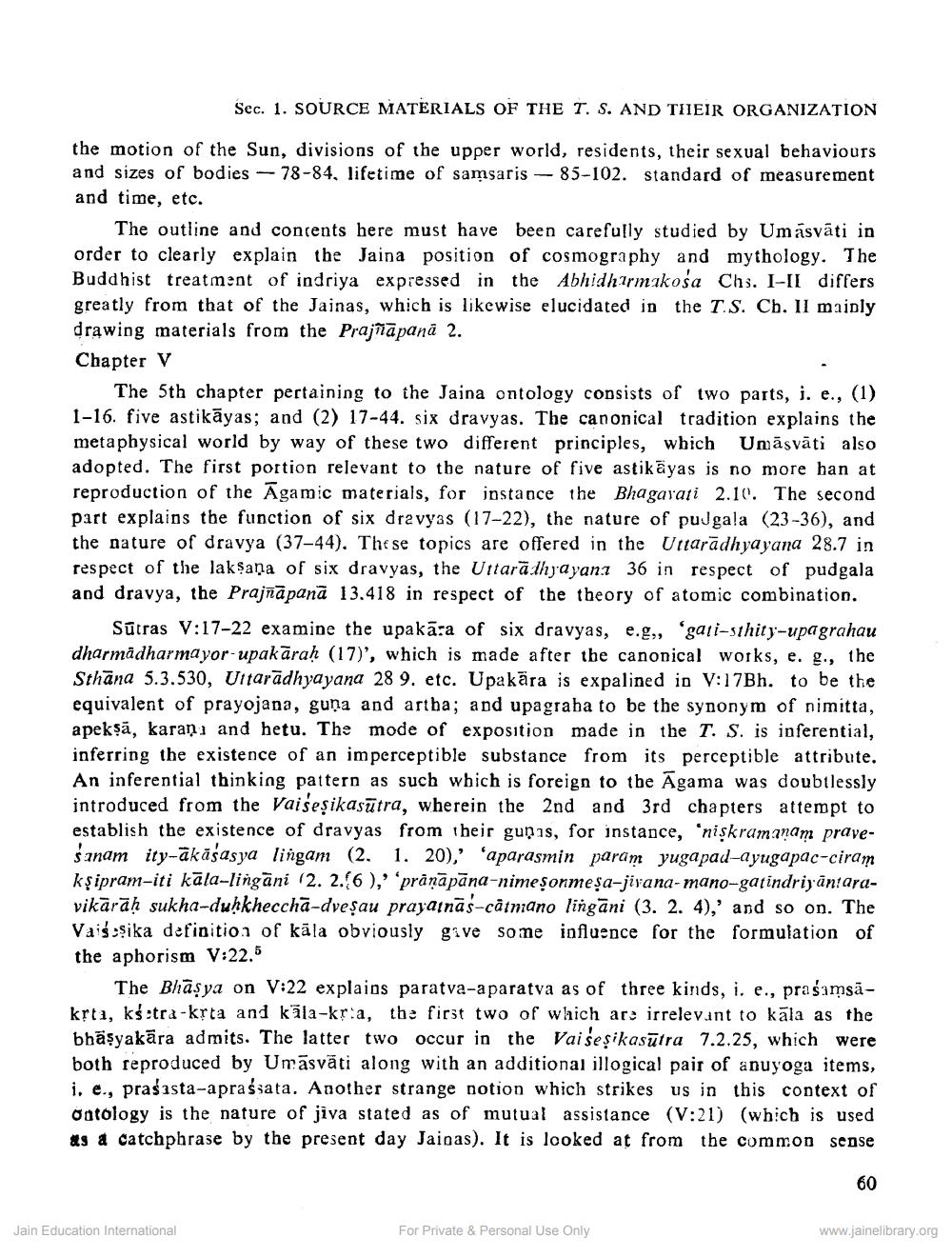________________
Sec. 1. SOURCE MATERIALS OF THE T. S. AND THEIR ORGANIZATION
the motion of the Sun, divisions of the upper world, residents, their sexual behaviours and sizes of bodies - 78-84, lifetime of samsaris - 85-102. standard of measurement and time, etc.
The outline and concents here must have been carefully studied by Umásvāti in order to clearly explain the Jaina position of cosmography and mythology. The Buddhist treatment of indriya expressed in the Abhidharmakosa Chs. I-II differs greatly from that of the Jainas, which is likewise elucidated in the T.S. Ch. Il mainly drawing materials from the Prajñāpanā 2. Chapter V
The 5th chapter pertaining to the Jaina ontology consists of two parts, i. e., (1) 1-16. five astikāyas; and (2) 17-44. six dravyas. The canonical tradition explains the metaphysical world by way of these two different principles, which Umāsvāti also adopted. The first portion relevant to the nature of five astikāyas is no more han at reproduction of the Agamic materials, for instance the Bhagavati 2.10. The second part explains the function of six dravyas (17-22), the nature of puugala (23-36), and the nature of dravya (37-44). These topics are offered in the Uttarādhyayana 28.7 in respect of the laksana of six dravyas, the Uttarādhyayanı 36 in respect of pudgala and dravya, the Prajñāpanā 13.418 in respect of the theory of atomic combination.
Sūtras V:17-22 examine the upakāra of six dravyas, e.g., 'gali-sthity-upagrahau dharmadharmayor-upakāraḥ (17)', which is made after the canonical works, e. g., the Sthāna 5.3.530, Untarādhyayana 28 9. etc. Upakära is expalined in V:17Bh. to be the equivalent of prayojana, guna and artha; and upagraba to be the synonym of nimitta, apekṣā, karani and hetu. The mode of exposition made in the T. S. is inferential, inferring the existence of an imperceptible substance from its perceptible attribute. An inferential thinking pattern as such which is foreign to the Agama was doubtlessly introduced from the Vaiseşikasūtra, wherein the 2nd and 3rd chapters attempt to establish the existence of dravyas from their guņis, for instance, 'nișkramanam praveŚ anam ity-ākāśasya lingam (2. 1. 20),' 'aparasmin param yugapad-ayugapac-ciram kşipram-iti kāla-lingāni (2. 2.(6),' 'prānāpāna-nimeşonmeşa-jirana-mano-gatindriyantaravikārāḥ sukha-duḥkheccha-dveşau prayainās-cātmano lingāni (3. 2. 4),' and so on. The Vaissika definition of kāla obviously gave some influence for the formulation of the aphorism V:22.5
The Bhāsya on V:22 explains paratva-aparatva as of three kinds, i. e., prasamsākrta, kŚtra-krta and kala-kria, the first two of which are irrelevant to kāla as the bhāşyakāra admits. The latter two occur in the Vaiseșikasūtra 7.2.25, which were both reproduced by Unāsvāti along with an additional illogical pair of anuyoga items, i, e., prasasta-aprassata. Another strange notion which strikes us in this context of Ontology is the nature of jiva stated as of mutual assistance (V:21) (which is used as a catchphrase by the present day Jaioas). It is looked at from the common sense
60
Jain Education International
For Private & Personal Use Only
www.jainelibrary.org




